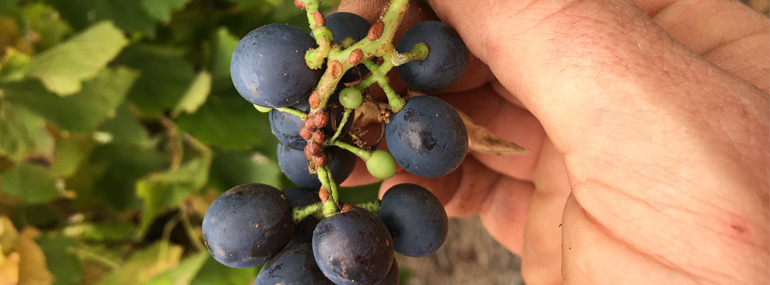Working to learn more about the ‘sooty mould’ dilemma
Two complementary projects under way at the Australian Wine Research Institute (AWRI) are looking to increase our knowledge about ‘sooty mould’, the distinctive fungal growth that can blacken grapes, leaves, canes and cordons to the extent that they appear to be covered with a fine layer of soot.

The projects are in response to recent outbreaks in regions including Langhorne Creek and the Adelaide Hills. Both have received funding from Wine Australia and involve winemaking and viticulture expertise at AWRI. Senior Viticulturist Marcel Essling has been involved from the start.
‘The vineyard project is about understanding the factors that led to sooty mould being a particular issue this season – uncovering what’s going on in the field that led to scale insects causing such damage’, he said.
‘Weather has probably played a role, it was cooler than normal and we missed out on heatwaves that would usually help control insect populations. But that does not explain why some vineyards were worse hit than others. We are planning to map the extent of the damage in several vineyards and then look back at management practices to see if an explanation can be found.’
Sooty mould is caused by fungi colonising areas of the vine where honeydew has been excreted by sap-sucking insects such as scale and mealybug. Scale insects, in particular, are common in most vineyards most of the time. Usually they are controlled by the weather or predatory insects, so sooty mould does not appear at levels where it is considered a problem, if at all.
To understand what has happened this year, Marcel, AWRI colleague Paul Petrie and consulting viticulturist Martin Moran will survey the affected vineyards to map out the distribution of the sooty mould across different blocks and then check spray diaries and management practices to see if they can find any relationships.
‘We’ll then go back and do another set of counts in winter’, Marcel said. ‘At the moment, we are measuring how bad the sooty mould is, not counting scale itself. Winter is the best time to monitor scale levels.’
The second project is designed to test how different amounts of sooty mould on grapes can affect the fermentation process and ultimately a wine’s sensory character.
The researchers have taken both affected and clean Shiraz fruit from the same vineyard then added sooty mould-affected fruit to the clean fruit in different proportions. The parcels of fruit will be made into wine by WIC Winemaking and the fermentation progress monitored. The finished wines will then be assessed by a trained sensory panel to look for any differences. This will complement a similar winemaking study with sooty mould affected fruit occurring in Wine Australia’s Regional Program in SA Central.
Both projects are due to be completed before the end of the year.